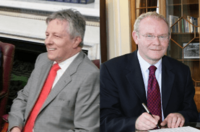Executive of the 4th Northern Ireland Assembly facts for kids
Quick facts for kids Executive of the 4th Northern Ireland Assembly |
|
|---|---|
| 3rd Executive of Northern Ireland | |
| Incumbent | |
 |
|
| Date formed | 16 May 2011 |
| Date dissolved | 6 May 2016 |
| People and organisations | |
| Head of state | Elizabeth II |
| Head of government | Peter Robinson (2011–15, Oct. 2015–Jan.2016) Arlene Foster (Sep.–Oct. 2015, Jan. 2016–) |
| Deputy head of government | Martin McGuinness (May–Sep. 2011; Oct. 2011–) John O'Dowd (Sep.–Oct. 2011) |
| No. of ministers | 11 |
| Member party | DUP Sinn Féin UUP (2011–15) SDLP Alliance |
| Status in legislature |
|
| History | |
| Election(s) | 2011 assembly election |
| Legislature term(s) | 4th Assembly |
| Predecessor | Executive of the 3rd Assembly |
| Successor | Executive of the 5th Assembly |
The Third Executive was the government of Northern Ireland from May 2011 to May 2016. It was a special type of government called a power-sharing coalition. This means that different political parties worked together to make decisions. This setup is part of the Northern Ireland Act 1998, which helps ensure fairness.
After the elections on 5 May 2011, the Democratic Unionist Party (DUP) and Sinn Féin were the two biggest parties. They played a key role in forming this government. The new Executive officially started on 16 May 2011.
Contents
What Was the 4th Northern Ireland Executive?
The Executive is like the main team that runs Northern Ireland. It's made up of ministers who are in charge of different government departments. Think of them as the heads of various teams, like education or health.
Who Led the Executive?
The Executive was led by two main people: the First Minister and the Deputy First Minister. They worked together to lead the government.
- The First Minister was Peter Robinson from the DUP. He served from 2011 to 2015, and again from October 2015 to January 2016.
- Arlene Foster also from the DUP, stepped in as acting First Minister for a short time in 2015 and then became First Minister in January 2016.
- The Deputy First Minister was Martin McGuinness from Sinn Féin. He served for most of the Executive's term. For a short time in 2011, John O'Dowd was the acting Deputy First Minister.
Important Ministers and Their Roles
Many different ministers were part of this Executive. They were responsible for important areas that affect everyone in Northern Ireland. Here are some of the key roles:
- Agriculture and Rural Development: This minister looked after farming and life in the countryside.
- Culture, Arts and Leisure: This role focused on promoting arts, sports, and cultural activities.
- Education: This minister was in charge of schools and learning for young people.
- Employment and Learning: This department helped people find jobs and get new skills.
- Enterprise, Trade and Investment: This minister worked to support businesses and encourage trade.
- Environment: This role was about protecting nature and dealing with environmental issues.
- Finance and Personnel: This minister managed the government's money and staff.
- Health, Social Services and Public Safety: This was a very important role, looking after hospitals, healthcare, and public safety.
- Justice: This minister was responsible for law and order.
- Regional Development: This role dealt with planning for roads, transport, and other regional projects.
- Social Development: This minister worked on social welfare and community support.
Over the years, some ministers changed roles or new people took over. This is normal in governments as leaders change or new elections happen.
What Are Junior Ministers?
Besides the main ministers, there were also Junior Ministers. These people helped the First Minister and Deputy First Minister with their work. They played an important role in supporting the top leaders and making sure things ran smoothly.
See also

